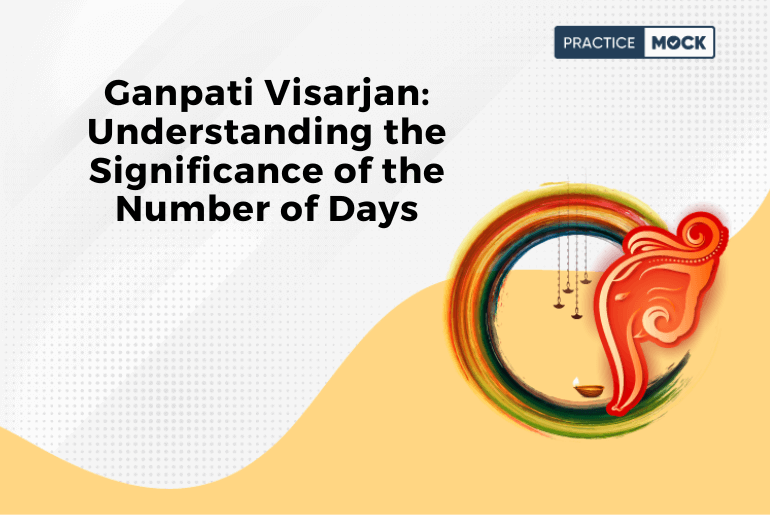

Ganesh Visarjan, the ritualistic immersion of Lord Ganesha idols, is one of the most vibrant and widely celebrated events in India. While the grand spectacle of Visarjan is well-known, the number of days over which it is observed varies across regions and households. In this article, we explore the significance of the number of days dedicated to Ganpati Visarjan and how it reflects cultural diversity and devotion.
गणपूज्यो वक्रतुण्ड एकदंष्ट्री त्रियम्बक:।
नीलग्रीवो लम्बोदरो विकटो विघ्रराजक :।।
धूम्रवर्णों भालचन्द्रो दशमस्तु विनायक:।
गणपर्तिहस्तिमुखो द्वादशारे यजेद्गणम।।’
One and a Half Day Ganpati Visarjan
One and a half days of Ganpati Visarjan is a popular choice among devotees. The idol is brought home on the first day, and the Visarjan takes place on the second day. This relatively shorter duration is preferred by many households, especially in urban areas, due to work commitments and space constraints. It allows devotees to seek blessings and enjoy the festivities without the need for an extended leave of absence.
Three, Five, or Seven Days of Celebrations
In contrast to the one and a half day Visarjan, some households opt for three, five, or seven days of Ganpati celebrations. These longer durations provide more time for elaborate rituals, cultural performances, and community gatherings. Devotees use this time to deepen their connection with Lord Ganesha, engage in bhajans (devotional songs), and participate in various cultural activities.
The Grand Finale: Ten-Day Ganpati Visarjan
The ten-day Ganpati Visarjan is the most extravagant and widely observed celebration. It begins with the installation of the idol, typically on Ganesh Chaturthi, and culminates with the Visarjan on Anant Chaturdashi. These ten days are marked by elaborate decorations, daily aartis (prayers), and a constant stream of devotees seeking Lord Ganesha’s blessings. The Visarjan procession during the ten-day celebration is a grand affair, with music, dance, and vibrant processions through the streets.
Significance of the Number of Days
The number of days chosen for Ganpati Visarjan often reflects the cultural traditions and beliefs of the devotees. Here are some reasons behind the choice of different durations:
One and a Half Day: Convenience and Devotion
Many people opt for a one and a half day Visarjan to balance their devotion with daily responsibilities. This shorter duration ensures that they can actively participate in the celebration without taking an extended leave from work or disrupting their daily routines.
Three to Seven Days: Cultural Significance
Longer celebrations lasting three to seven days provide an opportunity for cultural activities, including music, dance, and drama performances. Communities come together to celebrate and showcase their artistic talents during this time.
Ten-Day Celebration: Spiritual Intensity
The ten-day Ganpati Visarjan is considered the most spiritually intense period. Devotees engage in continuous prayer, meditation, and religious ceremonies to connect deeply with Lord Ganesha. It is a time for seeking blessings and guidance for various aspects of life.
Regional Variations
India’s cultural diversity is reflected in the varying traditions and customs associated with Ganpati Visarjan. Each region has its unique way of celebrating and immersing the idol.
In Maharashtra, the birthplace of the public Ganesh festival, the ten-day celebration is marked by grand processions, cultural performances, and massive Visarjan gatherings. In contrast, regions like Andhra Pradesh and Telangana often observe a one and a half day Visarjan with fervent prayers and offerings.
Environmental Awareness
In recent years, there has been a growing awareness of the environmental impact of Ganpati Visarjan, especially in the immersion of idols made from materials like plaster of Paris (PoP). Many individuals and communities are now opting for eco-friendly idols made of clay, which dissolve in water without causing harm to aquatic life. This environmentally conscious approach is becoming increasingly popular across different Visarjan durations.
Conclusion
Ganpati Visarjan is not just a religious ritual; it’s a celebration of culture, community, and devotion. The choice of the number of days for Visarjan reflects the diverse cultural traditions and preferences of devotees across India. Whether it’s a one and a half day celebration or the grandeur of a ten-day festivity, the essence remains the same—seeking the blessings of Lord Ganesha and uniting in joyous celebration. As environmental consciousness grows, so does the adoption of eco-friendly practices in the Visarjan ceremony, ensuring a harmonious coexistence with nature.
Recent Posts
Data Interpretation Important Question For SBI Clerk Mains 2025 Exam
In this article we are providing the Data Interpretation Important Question For the SBI Clerk…
AIC Management Trainee Syllabus 2025, Check Exam Pattern
Prepare for the AIC Management Trainee Exam 2025 with a clear understanding of the syllabus…
RRB JE CBT 2 Exam Date 2025 Out, Exam on 22 April
The RRB has released the RRB JE CBT 2 Exam Date 2025. Read this blog…
Banking Current Affairs PDF, Bazooka Download for Free
in this article we are providing the Bazooka Monthly Current Affairs PDF, Download Free PDFs.…
IBPS Application Reprint Link Activated for PO, Clerk and SO for Joining
The IBPS has released online application link for Clerk, PO and SO posts. Candidates can…
Weekly Current Affairs PDF 2025, Free Download For Banking, SSC Exams
Here we have provided Weekly Current Affairs 2024 PDF. Candidates can download Free Weekly Currents…


